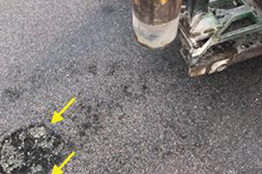
Seal coating has been widely used as a cost-effective strategy for asphalt pavement preservation, but some cities and counties have reported concerns about premature stripping. A recent study sponsored by the Minnesota Local Road Research Board (LRRB) investigated the mechanisms that cause asphalt pavement stripping under seal coats and provided recommendations to improve seal-coat implementation.
For the study, a Michigan Tech research team did a comprehensive field data collection from sites in Minnesota. Some possible causes of stripping were proposed after preliminary diagnoses, and corresponding laboratory testing was then conducted. Based on the laboratory testing results, the research team arrived at these general conclusions:
- The interface and shear bond strength between the laboratory seal-coat layer and the asphalt pavement layer decreased with the increase of freeze-thaw cycles.
- Weak asphalt-aggregate combination in seal-coat application and increased freeze-thaw cycles are the main factors for premature stripping of many seal-coat asphalt pavements. Due to multiple freeze-thaws and other factors, asphalt may be stripped from the aggregates of the asphalt mixture layers and the seal-coat layer.
- Further deterioration accelerates in the pavement system when partial damage occurs in the seal coats.
The study did not address what happens when there is no seal-coat failure—whether the seal coat protects the asphalt pavement or extends its service life. Based on the research that was conducted, the team could not conclude that seal coating is counterproductive.
The final report recommends methods to improve freeze-thaw resistance and improve seal-coat implementation.
Learn more:
- Is Seal Coating Counterproductive or Not? (LRRB/MnDOT, Dec. 2020)